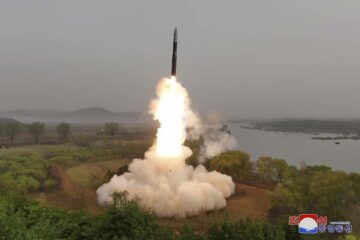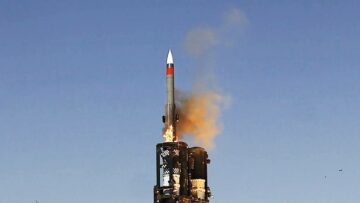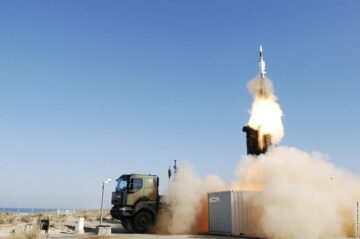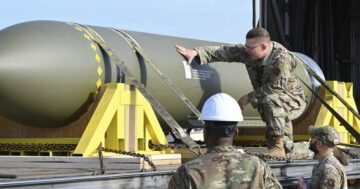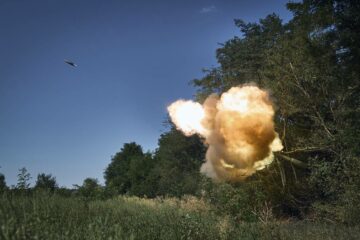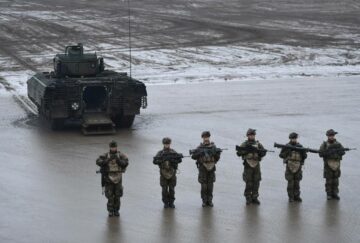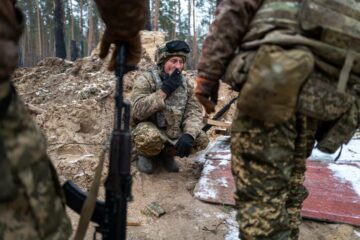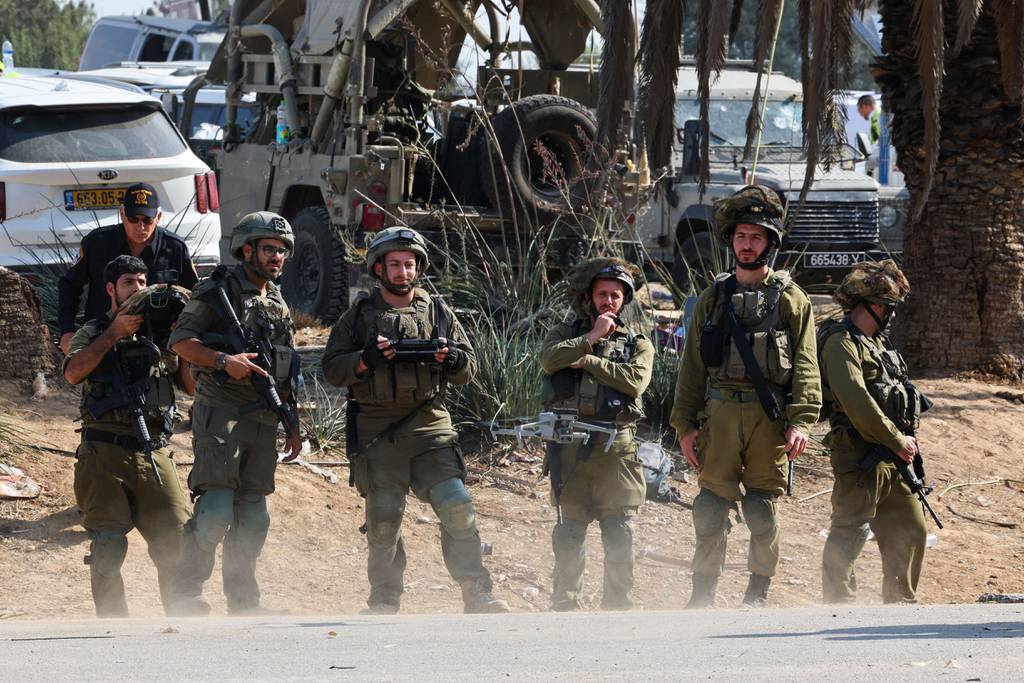
MILAN — The use of commercial drones in the Hamas terror group’s Oct. 7 attack on Israel is the latest example of how relatively low-tech warfare can catch sophisticated armies flat-footed, according to analysts.
Footage published by Al Qassam Brigades, Hamas’ military wing, showed that during the initial attacks that killed hundreds of Israeli civilians and prompted aerial bombardments of Gaza in return, fighters used armed drones to attack different Israeli military targets.
One video shows a quadcopter hovering above a communications tower near the Gaza border fence before releasing an explosive device on generators seconds later. Another one appears to show the same type of munition blowing up a machine gun turret on an Israeli Defense Forces’ observation post.
While drone tactics have become a staple of modern warfare, commercially available models have leveled the playing field for groups like Hamas, Raphael Cohen, director of the strategy and doctrine program at Rand, told Defense News.
“We’ve seen other terrorist groups use different sorts,” he said. Lebanese militant group “Hezbollah notably infiltrated Israeli territory a few years back and ISIS used a primitive drone to attack U.S. troops and so on,” he added, using the acronym for the Islamic State of Iraq and Syria group. “Given the plethora of hobby and commercial drones out there, you have to expect Hamas has and will use this capability going forward.”
While experts say it’s too early to talk about a large increase in the number of drones Hamas uses, they noted the initial attacks may have been their most advanced operation to date in disrupting infrastructure.
“I don’t know if Hamas is using drones more but they used them in a very sophisticated way in this case that has probably not been seen before,” said Mark Cancian, senior adviser at the Center for Strategic and International Studies in Washington.” It used drones as part of a combined arms attack, where the platforms struck watchtowers and video cameras to allow ground forces to move ahead.”
That kind of synchronization requires a lot of planning and training, he added.
Yaakov Lapin, research associate at the U.S.-based Israeli think tank MirYam Institute, added that some of the available footage of the attacks suggests the drones deployed by Hamas could have been used as part of a swarming strategy.
“Hamas used drones effectively to target sensors and armored vehicles, as part of a ‘swarming’ approach that also involved heavy rocket fire and a ground assault,” Lapin told Defense News. “It was one component, but an important one for this attack.”
All three experts warn that Hamas has likely observed battlefield drone usage in recent conflicts such as the Ukraine-Russia war, where commercial drones have played a large role.
“Hamas pays special attention to the way other non-state terror armies [or organizations] have used them, particularly ISIS, which has used them extensively,” Lapin said.
A central question in the opening hours of the Oct. 7 massacre remains how Israel, one of the pioneers of drone technology with a large arsenal of effective countermeasures, failed to detect the Hamas drones.
Part of the answer lies in the fact that small unmanned aircraft can be difficult to spot for even advanced sensors. And Israel is not alone in having witnessed this kind of breach.
“It is notable that the Russians and Ukrainians — who are also focused on this same problem — have struggled in this area and the same is true for other militaries,” Cohen said.
According to Cohen, two other factors are likely to have played a role: resources spread thin and a lack of prior intelligence about the strikes launched by Hamas.
“All air defenses are finite commodities and Hamas sent a lot at Israel all at once — not just UAS, but rockets as well,” Cohen said. “It is also clear that Israel was caught flat-footed by the attack. All the best technology in the world will not help if the soldiers operating it are not alert.”
Elisabeth Gosselin-Malo is a Europe correspondent for Defense News. She covers a wide range of topics related to military procurement and international security, and specializes in reporting on the aviation sector. She is based in Milan, Italy.
- SEO Powered Content & PR Distribution. Get Amplified Today.
- PlatoData.Network Vertical Generative Ai. Empower Yourself. Access Here.
- PlatoAiStream. Web3 Intelligence. Knowledge Amplified. Access Here.
- PlatoESG. Carbon, CleanTech, Energy, Environment, Solar, Waste Management. Access Here.
- PlatoHealth. Biotech and Clinical Trials Intelligence. Access Here.
- Source: https://www.defensenews.com/global/mideast-africa/2023/10/18/hamas-drones-helped-catch-israel-off-guard-experts-say/
- :has
- :is
- :not
- :where
- $UP
- 10
- 7
- 70
- a
- About
- above
- According
- added
- advanced
- adviser
- ahead
- AIR
- aircraft
- AL
- Alert
- All
- allow
- alone
- also
- an
- Analysts
- and
- Another
- answer
- appears
- approach
- ARE
- AREA
- armed
- arms
- Arsenal
- AS
- Associate
- At
- attack
- Attacks
- attention
- available
- aviation
- back
- based
- Battlefield
- BE
- become
- been
- before
- BEST
- Blowing
- border
- breach
- but
- by
- cameras
- CAN
- capability
- case
- Catch
- caught
- Center
- central
- civilians
- clear
- cohen
- combined
- commercial
- commercially
- Commodities
- Communications
- component
- conflicts
- could
- covers
- Date
- Defense
- deployed
- detect
- device
- different
- difficult
- Director
- Dont
- drone
- drone technology
- Drones
- during
- Early
- Effective
- effectively
- Europe
- Even
- example
- expect
- experts
- extensively
- fact
- factors
- Failed
- fence
- few
- field
- fighters
- Fire
- focused
- For
- Forces
- Forward
- generators
- going
- Ground
- Group
- Group’s
- Guard
- Have
- having
- he
- heavy
- help
- helped
- HOURS
- How
- HTTPS
- Hundreds
- if
- images
- important
- in
- Increase
- Infrastructure
- initial
- Institute
- Intelligence
- International
- involved
- iraq
- Islamic
- Islamic State
- Israel
- Israeli
- IT
- Italy
- jpg
- just
- Kind
- Know
- Lack
- large
- later
- latest
- launched
- Lebanese
- lies
- like
- likely
- Lot
- machine
- mark
- May..
- MILAN
- militaries
- Military
- models
- Modern
- Modern Warfare
- more
- most
- move
- Near
- news
- notable
- notably
- noted
- number
- observation
- observed
- Oct
- of
- off
- on
- once
- ONE
- opening
- operating
- operation
- or
- organizations
- Other
- out
- part
- particularly
- pays
- pioneers
- planning
- Platforms
- plato
- Plato Data Intelligence
- PlatoData
- played
- playing
- plethora
- Post
- primitive
- Prior
- probably
- Problem
- procurement
- Program
- published
- question
- rand
- range
- recent
- related
- relatively
- releasing
- remains
- Reporting
- requires
- research
- Resources
- return
- rocket
- Role
- Russians
- s
- Said
- same
- say
- seconds
- sector
- security
- seen
- senior
- sensors
- sent
- she
- show
- showed
- Shows
- small
- So
- some
- sophisticated
- special
- specializes
- Spot
- spread
- State
- Strategic
- Strategy
- Strikes
- studies
- such
- Suggests
- synchronization
- Syria
- tactics
- Talk
- tank
- Target
- targets
- Technology
- territory
- terrorist
- that
- The
- the world
- their
- Them
- There.
- they
- Think
- think tank
- this
- three
- to
- told
- too
- Topics
- Tower
- Training
- true
- two
- type
- u.s.
- Ukraine-Russia war
- Ukrainians
- Usage
- use
- used
- uses
- using
- Vehicles
- very
- Video
- war
- was
- washington
- Way..
- WELL
- which
- WHO
- wide
- Wide range
- will
- Wing
- with
- witnessed
- world
- years
- you
- zephyrnet

